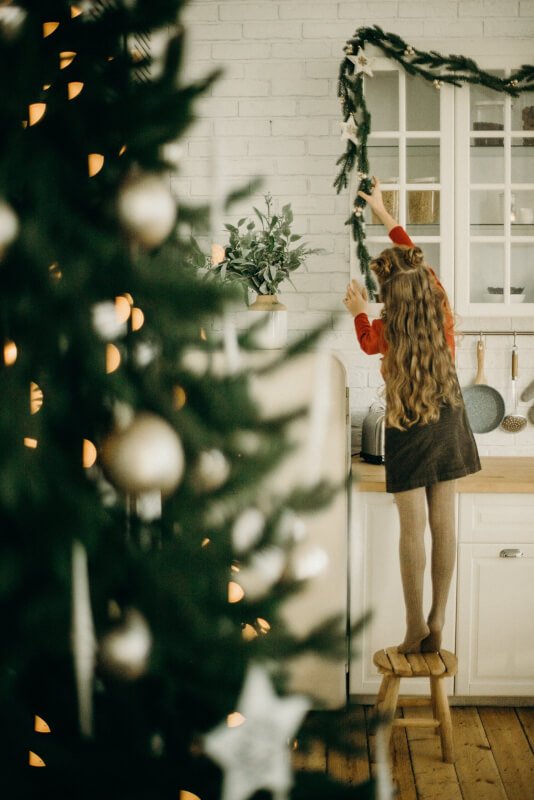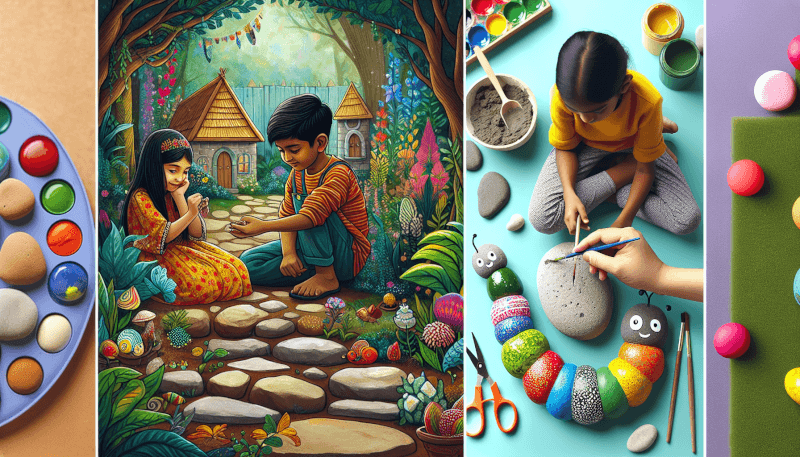Are you looking for fun and engaging activities to keep your kids entertained this summer? Look no further than easy DIY garden projects! From planting their very own vegetable patches to creating unique fairy gardens, these projects offer a wonderful opportunity for children to explore the outdoors, learn about nature, and develop their creativity. With simple materials and step-by-step instructions, these projects are perfect for little hands and big imaginations. Get ready to watch your children’s love for nature bloom as they embark on these exciting and educational garden adventures!

1. Fairy Garden
Creating a fairy garden is a fun and magical project that will spark your imagination and bring a touch of enchantment to your outdoor space. Follow these simple steps to create your own whimsical fairy garden.
1.1 Choose a Theme
Before you get started, it’s important to choose a theme for your fairy garden. This could be anything from a fairy village to a mystical woodland. Think about what elements you want to include, such as flowers, trees, and fairy accessories, and let your creativity guide you.
1.2 Select a Container
Next, you’ll need to choose a container for your fairy garden. You can use anything from an old wheelbarrow to a large pot or even a small corner in your garden. Just make sure it has enough space to accommodate your miniature landscape.
1.3 Gather Materials
To create your fairy garden, you’ll need some basic materials. This includes potting soil, small plants or flowers, pebbles or rocks, and moss. You may also want to gather some sticks, twigs, and other natural materials to use as decoration.
1.4 Create a Miniature Landscape
Now it’s time to start creating your miniature landscape. Begin by filling your container with potting soil, making sure to leave enough space for your plants. Arrange the soil to create different levels and slopes, adding rocks or pebbles to create pathways or a riverbed.
1.5 Add Fairy Accessories
To bring your fairy garden to life, it’s important to add some fairy accessories. This could include miniature houses, fences, benches, and even a tiny pond or bird bath. Get creative and use natural materials like twigs and leaves to make your own fairy furniture and decorations.
1.6 Maintain and Care for the Fairy Garden
Once your fairy garden is complete, you’ll need to take care of it to keep it looking its best. This includes regular watering, removing any dead or wilted plants, and pruning if necessary. You may also need to adjust the placement of your accessories to ensure they don’t become overgrown or damaged.
2. Recycled Bottle Planters
If you’re looking for an eco-friendly and creative way to grow plants, recycled bottle planters are the perfect solution. Not only do they make use of materials that would otherwise end up in the trash, but they also provide a unique and eye-catching display.
2.1 Collect Empty Plastic Bottles
The first step in creating your recycled bottle planters is to collect empty plastic bottles. Look for bottles of different sizes and shapes, as this will add variety to your planter display. Rinse them out thoroughly and remove any labels or stickers.
2.2 Prepare the Bottles
Once you have your bottles, you’ll need to prepare them for planting. Use a sharp knife or scissors to cut off the top of the bottle, leaving a wide enough opening for your plants to grow. You can also remove the cap if desired.
2.3 Add Drainage Holes
To ensure proper drainage, it’s important to add some holes to the bottom of your bottle planters. Use a nail or a drill to create several small holes in the bottom of each bottle. This will prevent water from pooling and causing root rot.
2.4 Fill with Soil and Plant Seeds
Now it’s time to fill your bottle planters with soil and plant your seeds or seedlings. Choose plants that are well-suited for container gardening, such as herbs or small flowers. Fill each bottle with potting soil, leaving enough space for your plants to grow.
2.5 Water and Nurture the Plants
After planting your seeds or seedlings, make sure to water them regularly and provide them with the appropriate amount of sunlight. Take care not to overwater, as this can lead to root rot. Keep an eye out for any signs of pests or diseases and take appropriate action if necessary.
2.6 Decorate the Bottle Planters
To add a personal touch to your recycled bottle planters, consider decorating them. You can use paint, markers, or even stickers to add designs or labels to each planter. This will not only make them more visually appealing but will also help you keep track of what you’ve planted in each bottle.

3. DIY Bird Feeders
Creating your own bird feeders is a wonderful way to attract a variety of bird species to your garden and provide them with a source of food. It’s a fun and educational project that kids of all ages will enjoy.
3.1 Choose a Bird Feeder Design
There are many different types of bird feeders you can make, from simple tray feeders to more elaborate homemade designs. You can choose based on the materials you have on hand and the type of birds you want to attract. Some popular options include platform feeders, tube feeders, and suet feeders.
3.2 Gather Required Materials
Once you’ve decided on a bird feeder design, gather all the necessary materials. This may include wood, plastic bottles, pinecones, strings, and birdseed. It’s also a good idea to have some tools on hand, such as a saw, drill, or hot glue gun, depending on the design you choose.
3.3 Construct the Bird Feeder
Follow the instructions for your chosen bird feeder design to construct the feeder. This could involve cutting and assembling wood pieces, creating holes for feeding ports, or attaching strings or wires for hanging. Make sure to take proper safety precautions and involve adult supervision if necessary.
3.4 Add Bird Food
Once your bird feeder is complete, it’s time to add bird food. Choose a high-quality birdseed mix that is suitable for the species of birds you want to attract. You can also consider adding other food options, such as suet or chopped fruits, to attract a wider variety of birds.
3.5 Hang or Place the Bird Feeder
Find a suitable location to hang or place your bird feeder. It should be in an area that is easily visible and accessible to birds, but also safe from predators. Make sure to hang or mount the feeder securely to prevent it from falling or being knocked over by strong winds.
3.6 Observe and Enjoy Bird Watching
Once your bird feeder is set up, take some time to observe and enjoy the birds that visit your garden. Keep a bird identification guide handy to identify different species. Encourage your kids to keep a journal or draw pictures of the birds they see, and learn more about their behavior and habitat.
4. Herb Garden Markers
If you’re growing herbs in your garden, herb garden markers are a fun and practical way to keep track of your plants. They add a decorative touch to your garden while ensuring you can easily identify each herb and harvest them at the right time.
4.1 Select Herb Varieties
Before you can create your herb garden markers, you’ll need to choose the herb varieties you want to grow. Consider which herbs you use most often in cooking and select those that will thrive in your climate and soil conditions. Popular choices include basil, rosemary, thyme, and mint.
4.2 Gather Materials
To make herb garden markers, you’ll need some basic materials. This includes wooden or plastic stakes, paint or markers, and waterproof varnish or clear coat. You may also want to gather some decorative embellishments, such as ribbons, beads, or small plastic herbs, to personalize your markers.
4.3 Prepare the Markers
Start by preparing your garden markers. If using wooden stakes, you may need to sand them lightly to ensure a smooth surface. If using plastic stakes, make sure they are clean and free from any debris. This step will help the paint adhere properly.
4.4 Label the Herb Plants
Once your markers are prepared, it’s time to label them. Use paint or markers to write the names of the different herbs on each marker. You can also get creative and add decorative elements, such as herb-themed illustrations, to make your markers more visually appealing.
4.5 Insert the Markers into the Soil
After labeling your markers, insert them into the soil next to each herb plant. Make sure they are secure and easily visible. You can adjust the height of the markers to ensure they are easily seen and read from a standing position.
4.6 Maintain and Harvest the Herbs
As your herbs grow, it’s important to maintain them properly. This includes regular watering, weeding, and pruning if necessary. Take care to monitor each herb’s growth and harvest them at the right time to ensure the best flavor and fragrance. The herb garden markers will be your guide in identifying each herb as they grow.

5. Pallet Planter Boxes
Pallet planter boxes are a popular DIY project that allows you to repurpose old pallets and create a unique and rustic display for your plants. They are a great option if you have limited space or want to add some vertical gardening to your outdoor area.
5.1 Source a Pallet
The first step in creating your pallet planter boxes is to find a suitable pallet. Look for pallets that are in good condition and made of untreated wood. You can often find pallets for free at local businesses, warehouses, or through online classifieds.
5.2 Disassemble the Pallet
Once you have your pallet, disassemble it to create the individual planks you’ll need for your planter boxes. Carefully remove the nails or staples holding the pallet together using a pry bar or hammer. Take your time to avoid splintering or damaging the wood.
5.3 Cut and Assemble the Planter Box
Using the dismantled planks, cut them to the desired length for your planter box. You will need four pieces for the sides and additional pieces for the base and ends depending on the size of the box you want to create. Once you have your pieces cut, assemble them using nails or screws to create the basic structure of the planter box.
5.4 Line the Box and Add Soil
To ensure proper drainage and prevent the wood from rotting, it’s important to line your planter box with a plastic sheet or landscape fabric. This will create a barrier between the soil and the wood. Once you have lined the box, add a layer of potting soil and compost, leaving enough space for your plants.
5.5 Choose and Plant the Desired Plants
Now it’s time to choose the plants you want to grow in your planter box. Consider the amount of sunlight the area receives and select plants that are well-suited for your growing conditions. You can choose flowering plants, herbs, or even vegetables, depending on your preferences and available space.
5.6 Water and Care for the Plants
After planting your desired plants, make sure to water them regularly and provide them with the required care. Monitor the moisture levels in the soil to avoid overwatering or underwatering. You may also need to prune or fertilize your plants as they grow to ensure healthy and vibrant growth.
6. DIY Bug Hotel
A bug hotel is a creative and educational project that provides shelter and habitat for beneficial insects in your garden. It’s a great way to attract pollinators, predators of garden pests, and other fascinating creatures. Here’s how to create your own bug hotel.
6.1 Learn about Insects and Their Habitats
Before you start building your bug hotel, take some time to learn about the different types of insects that you can attract to your garden. Research their habitats and the features they require to thrive. This will help you design a bug hotel that meets their specific needs.
6.2 Gather Natural Materials
To build your bug hotel, gather a variety of natural materials such as pinecones, sticks, twigs, bamboo canes, and hollow plant stems. These materials will provide a variety of nesting options for different insects. You can also include rocks, bark, and leaves to create different layers and habitats.
6.3 Stack and Secure Materials
Start building your bug hotel by stacking the materials in layers or compartments. For example, you can create a section for bees using hollow plant stems, or a section for ladybugs using twigs and pinecones. Secure the materials together using twine, wire, or a strong adhesive.
6.4 Add Additional Features
To make your bug hotel even more attractive to insects, consider adding additional features. This could include a small water source, such as a shallow dish or saucer filled with water, or a patch of mud for butterflies and solitary bees. These features will provide essential resources for the insects.
6.5 Place the Bug Hotel in the Garden
Once your bug hotel is complete, find a suitable location in your garden to place it. Choose an area that receives partial sunlight and is protected from strong winds. Make sure the bug hotel is stable and secure, and that it won’t be easily knocked over or damaged.
6.6 Observe and Learn about Insects
Now it’s time to sit back and observe the insects that visit your bug hotel. Keep a close eye on the different compartments and sections to see which insects take up residence. You can use identification guides or online resources to learn more about the insects and their roles in the ecosystem.

7. Garden Wind Chimes
Garden wind chimes are a beautiful and soothing addition to any outdoor space. Not only do they create pleasant sounds as the wind blows, but they also add visual interest and can be a great DIY project for kids. Here’s how to make your own garden wind chimes.
7.1 Collect Recyclable Materials
To create your wind chimes, start by collecting recyclable materials from around your home. This could include old keys, seashells, bottle caps, small metal or wooden objects, and even old silverware. Get creative and choose materials that have interesting shapes or textures.
7.2 Create the Wind Chime Base
Next, you’ll need to create the base for your wind chime. This can be made from a variety of materials, such as a metal hoop, a wooden branch, or a piece of driftwood. Ensure that the base is sturdy and will be able to support the weight of the chimes.
7.3 Decorate and Attach the Chimes
Once you have your base, it’s time to decorate and attach the chimes. You can paint or decorate the base to match your garden’s aesthetic, or leave it natural for a rustic look. Attach the chimes to the base using fishing line, wire, or string, ensuring that they are evenly spaced and will move freely in the wind.
7.4 Hang the Wind Chime in the Garden
Find a suitable location in your garden to hang your wind chime. This could be from a tree branch, a pergola, or a shepherd’s hook. Consider the direction of the prevailing winds and hang the wind chime where it will catch the most breeze.
7.5 Enjoy the Soothing Sounds
Once your wind chime is hung, sit back and enjoy the soothing sounds it creates as the wind blows. Spend some time in your garden, relax, and let the chimes provide a peaceful atmosphere. You can also encourage your kids to listen carefully and identify the different sounds each chime makes.
7.6 Maintain and Repair the Wind Chime
To ensure your wind chime lasts for a long time, it’s important to maintain it properly. Regularly inspect the chimes and the base for any signs of damage or wear. Replace any broken or damaged chimes, and tighten any loose connections. Additionally, take the wind chime down during storms or strong winds to avoid damage.
8. Plant Pot Painting
Adding a splash of color to your garden is easy with painted plant pots. This simple DIY project allows you to personalize your plant pots and create unique and eye-catching displays. Here’s how to paint your own plant pots.
8.1 Select and Clean Terracotta Pots
Start by selecting terracotta pots that you want to paint. Terracotta pots are a popular choice because they are porous and allow plants to breathe. Once you have your pots, clean them thoroughly to remove any dirt, dust, or debris. This will ensure that the paint adheres to the surface properly.
8.2 Choose a Design or Pattern
Next, decide on a design or pattern for your painted plant pots. You can go for something simple, like stripes or polka dots, or get more creative and paint landscapes, animals, or abstract designs. Consider the style and theme of your garden and let your imagination run wild.
8.3 Paint the Pots
Once you have your design in mind, it’s time to start painting. Use acrylic craft paint or outdoor paint that is suitable for terracotta pots. Apply a base coat of paint to the entire surface of the pot, and let it dry completely. Then, paint your design using a small brush or sponge, and let it dry again.
8.4 Add Personal Touches and Details
To make your painted plant pots even more unique, consider adding personal touches and details. This could include adding the names of the plants, adding a border or trim, or even using stencils or stamps to create patterns or shapes. Get creative and have fun with it.
8.5 Seal the Painted Pots
Once your paint has dried completely, it’s important to seal the painted plant pots to protect them from the elements. Use a clear spray sealer or brush-on varnish to create a protective barrier. Make sure to follow the instructions on the sealer or varnish for best results.
8.6 Plant Flowers or Herbs in the Decorated Pots
After the sealer has dried, your painted plant pots are ready to be used. Fill them with potting soil and plant your desired flowers or herbs. Choose plants that are well-suited for container gardening and ensure they receive the appropriate care and maintenance.

9. Garden Stepping Stones
Garden stepping stones are not only a practical element in your garden but also a beautiful way to add personality to your outdoor space. Whether you want to create a path or simply add decorative accents, making your own garden stepping stones is a fun project for the whole family.
9.1 Prepare a Stepping Stone Mold
The first step in making your own garden stepping stones is to prepare a mold. You can use pre-made molds or create your own using materials like plastic containers or cake pans. Consider the size and shape of the mold you want to use and make sure it’s suitable for your garden design.
9.2 Mix and Pour Concrete
Next, you’ll need to mix and pour the concrete for your stepping stones. You can use a ready-to-use concrete mix or mix your own using cement, sand, and water. Follow the instructions on the concrete mix and make sure to wear protective gloves and goggles.
9.3 Decorate the Stepping Stones
Before the concrete sets, it’s time to add decorative elements to your stepping stones. You can embed mosaic tiles, glass beads, shells, or stones into the wet concrete to create interesting patterns or designs. Get creative and use different colors and textures to personalize your stepping stones.
9.4 Let the Concrete Cure
Once you have decorated your stepping stones, it’s important to let the concrete cure properly. This can take several days, depending on the type of concrete mix and the weather conditions. Follow the manufacturer’s instructions for the recommended curing time.
9.5 Place the Stepping Stones in the Garden
After the concrete has cured, your garden stepping stones are ready to be placed in your garden. Arrange them in a pattern or pathway of your choice, making sure they are evenly spaced and stable. You can also add some potting soil or gravel around the stones to create a seamless transition.
9.6 Maintain and Clean the Stepping Stones
To keep your garden stepping stones looking their best, it’s important to maintain and clean them regularly. Sweep away any debris or leaves, and remove any weeds that may grow between the stones. You can also clean the stones with a mild soap and water solution if they become dirty or stained.
10. Leaf Rubbings
Leaf rubbings are a simple and enjoyable activity that allows you to create beautiful and unique artwork using the natural shapes and textures of leaves. It’s a great project for kids of all ages and a wonderful way to explore the beauty of nature.
10.1 Collect Different Types of Leaves
Start by collecting an assortment of leaves from your garden or a nearby park. Look for leaves of different shapes and sizes, as well as leaves with interesting textures or patterns. Make sure to collect leaves that are still fresh and pliable, as they will create the best rubbings.
10.2 Choose a Suitable Surface
To create leaf rubbings, you’ll need a suitable surface to work on. This could be a piece of plain white paper or a sheet of tracing paper. If using tracing paper, make sure it’s secured firmly on top of the leaf to prevent it from moving during the rubbing process.
10.3 Arrange Leaves on the Surface
Once you have your surface ready, arrange the leaves on top of it. Consider the composition and placement of the leaves, and get creative with different arrangements. You can overlap the leaves or arrange them in a pattern, depending on the effect you want to achieve.
10.4 Cover with Paper and Secure
After arranging the leaves, cover them with another sheet of paper or tracing paper. Make sure it’s large enough to completely cover the leaves and secure it firmly on all sides. This will prevent the leaves from shifting or moving during the rubbing process.
10.5 Rub Over the Leaves with Crayons
With the leaves and paper securely in place, it’s time to start rubbing. Take a crayon or colored pencil and hold it at an angle. Gently rub the side of the crayon over the paper, directly on top of the leaf. As you rub, you will start to see the shape and texture of the leaf appear on the paper.
10.6 Remove the Leaves and Display the Rubbings
Once you have finished rubbing over the entire surface of the leaves, carefully remove the leaves and set them aside. Take a moment to admire the leaf rubbings and appreciate the unique patterns and textures that have been captured. You can display the rubbings as they are or use them in other art projects, such as collages or cards.


